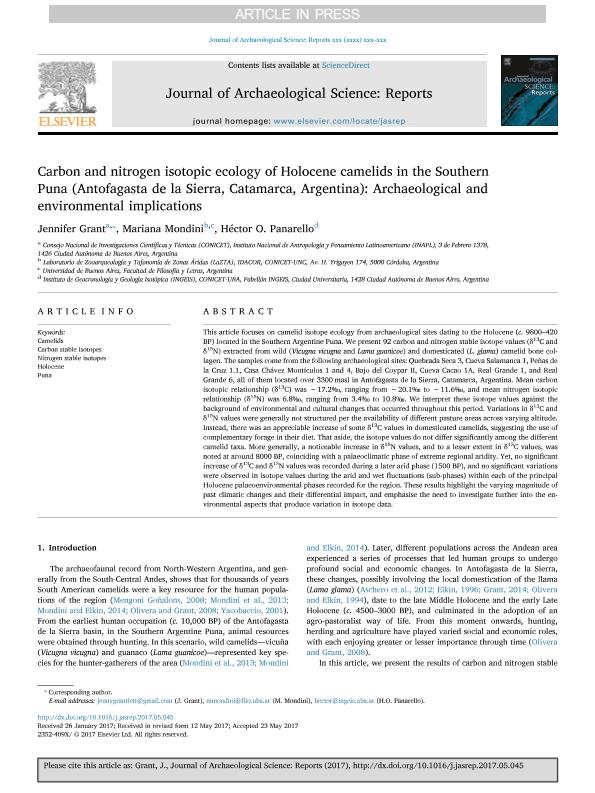Mostrar el registro sencillo del ítem
dc.contributor.author
Grant Lett Brown, Jennifer Luisa

dc.contributor.author
Mondini, Nora Mariana

dc.contributor.author
Panarello, Hector Osvaldo

dc.date.available
2018-04-05T17:09:15Z
dc.date.issued
2017-06
dc.identifier.citation
Grant Lett Brown, Jennifer Luisa; Mondini, Nora Mariana; Panarello, Hector Osvaldo; Carbon and nitrogen isotopic ecology of Holocene camelids in the Southern Puna (Antofagasta de la Sierra, Catamarca, Argentina): Archaeological and environmental implications; Elsevier Science; Journal of Archaeological Science: Reports; 6-2017; 1-11
dc.identifier.issn
2352-409X
dc.identifier.uri
http://hdl.handle.net/11336/40891
dc.description.abstract
This article focuses on camelid isotope ecology from archaeological sites dating to the Holocene (c. 9,800-420 BP) located in the Southern Argentine Puna. We present 92 carbon and nitrogen stable isotope values (δ13C and δ15N) extracted from wild (Vicugna vicugna and Lama guanicoe) and domesticated (L. glama) camelid bone collagen. The samples come from the following archaeological sites: Quebrada Seca 3, Cueva Salamanca 1, Peñas de la Cruz 1.1, Casa Chávez Montículos 1 and 4, Bajo del Coypar II, Cueva Cacao 1A, Real Grande 1, and Real Grande 6, all of them located over 3,300 masl in Antofagasta de la Sierra, Catamarca, Argentina. Mean carbon isotopic relationship (δ13C) was -17.2?, ranging from -20.1? to -11.6?, and mean nitrogen isotopic relationship (δ15N) was 6.8?, ranging from 3.4? to 10.8?. We interpret these isotope values against the background of environmental and cultural changes that occurred throughout this period. Variations in δ13C and δ15N values were generally not structured per the availability of different pasture areas across varying altitude. Instead, there was an appreciable increase of some δ13C values in domesticated camelids, suggesting the use of complementary forage in their diet. That aside, the isotope values do not differ significantly among the different camelid taxa. More generally, a noticeable increase in δ15N values, and to a lesser extent in δ13C values, was noted at around 8,000 BP, coinciding with a palaeoclimatic phase of extreme regional aridity. Yet, no significant increase of δ13C and δ15N values was recorded during a later arid phase (1,500 BP), and no significant variations were observed in isotope values during the arid and wet fluctuations (sub-phases) within each of the principal Holocene palaeoenvironmental phases recorded for the region. These results highlight the varying magnitude of past climatic changes and their differential impact, and emphasise the need to investigate further into the environmental aspects that produce variation in isotope data.
dc.format
application/pdf
dc.language.iso
eng
dc.publisher
Elsevier Science

dc.rights
info:eu-repo/semantics/openAccess
dc.rights.uri
https://creativecommons.org/licenses/by-nc-nd/2.5/ar/
dc.subject
Camelids
dc.subject
Carbon And Nitrogen Stalbe Isotopes
dc.subject
Holocene
dc.subject
Puna
dc.subject.classification
Historia

dc.subject.classification
Historia y Arqueología

dc.subject.classification
HUMANIDADES

dc.title
Carbon and nitrogen isotopic ecology of Holocene camelids in the Southern Puna (Antofagasta de la Sierra, Catamarca, Argentina): Archaeological and environmental implications
dc.type
info:eu-repo/semantics/article
dc.type
info:ar-repo/semantics/artículo
dc.type
info:eu-repo/semantics/publishedVersion
dc.date.updated
2018-04-03T18:45:16Z
dc.journal.pagination
1-11
dc.journal.pais
Países Bajos

dc.journal.ciudad
Amsterdam
dc.description.fil
Fil: Grant Lett Brown, Jennifer Luisa. Consejo Nacional de Investigaciones Científicas y Técnicas; Argentina. Secretaría de Cultura de la Nación. Dirección Nacional de Cultura y Museos. Instituto Nacional de Antropología y Pensamiento Latinoamericano; Argentina
dc.description.fil
Fil: Mondini, Nora Mariana. Universidad de Buenos Aires; Argentina. Consejo Nacional de Investigaciones Científicas y Técnicas. Centro Científico Tecnológico Conicet - Córdoba. Instituto de Antropología de Córdoba. Universidad Nacional de Córdoba. Facultad de Filosofía y Humanidades. Instituto de Antropología de Córdoba; Argentina
dc.description.fil
Fil: Panarello, Hector Osvaldo. Consejo Nacional de Investigaciones Científicas y Técnicas. Oficina de Coordinación Administrativa Ciudad Universitaria. Instituto de Geocronología y Geología Isotopica. Universidad de Buenos Aires. Facultad de Ciencias Exactas y Naturales. Instituto de Geocronología y Geología Isotópica; Argentina
dc.journal.title
Journal of Archaeological Science: Reports
dc.relation.alternativeid
info:eu-repo/semantics/altIdentifier/doi/http://dx.doi.org/10.1016/j.jasrep.2017.05.045
dc.relation.alternativeid
info:eu-repo/semantics/altIdentifier/url/https://www.sciencedirect.com/science/article/pii/S2352409X17300469
Archivos asociados
